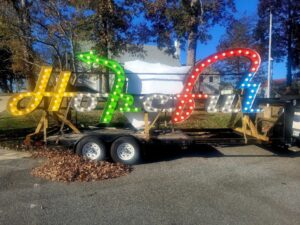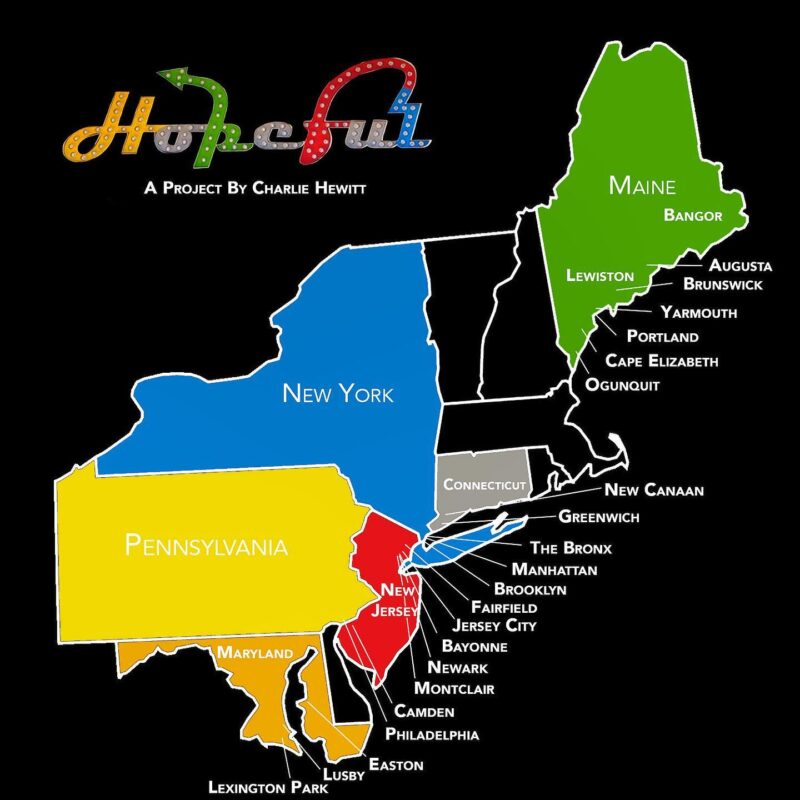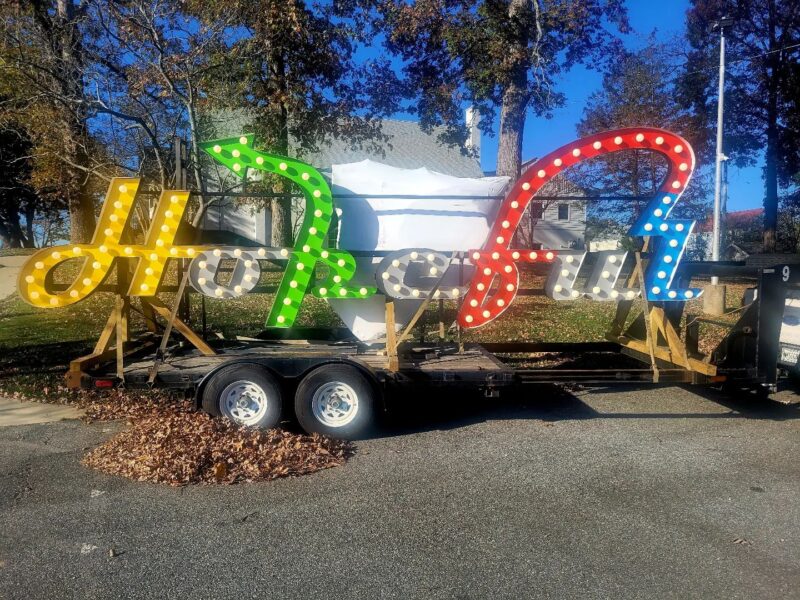 In early spring 2022, St. Mary’s CDC was approached by a small group of local art-lovers with an idea: how to bring hope to Lexington Park. This idea of “hope” began with Charlie Hewitt, a renowned artist from St. Mary’s County who now lives in Portland, Maine, and his nationwide “Hopeful Project”.
In early spring 2022, St. Mary’s CDC was approached by a small group of local art-lovers with an idea: how to bring hope to Lexington Park. This idea of “hope” began with Charlie Hewitt, a renowned artist from St. Mary’s County who now lives in Portland, Maine, and his nationwide “Hopeful Project”.
Charlie’s artwork–which may remind one of the large marquee signs you would see at a movie theater from years past–is painted colorfully and lit with LED bulbs, ultimately spelling out his project’s namesake: HOPEFUL.
The Hopeful Project’s 2019 inception was inspired by New England’s dark winters and Charlie’s desire to not only bring light to his community but to also stimulate unity, togetherness, and optimism. Charlie has installed his full-scale Hopeful Project pieces in big cities and small towns all over the east coast, as close as Easton, Maryland, and a miniature version of the sign has a home at Ann Marie Gardens in Solomons. We are honored and thrilled to welcome Charlie’s positive message in the community where he grew up!
To start at the beginning, the steering group–which included the aforementioned art-lovers, in addition to the executive director of St. Mary’s County Arts Council (SMCAC) Nell Elder, the CDC executive director Taylor Smith, and a member of the CDC’s board of directors–gathered in early spring to determine the scope and direction of Lexington Park’s Hopeful Project. Conversations on location prioritized the Great Mills Road corridor, the main drag through Lexington Park and the focal point of the CDC’s mission. The group considered it necessary for the public art piece to be placed in a location where it would be seen and appreciated, as it deserves to be.
Most importantly, however, the steering group’s discussions quickly led to the objective of implementing programming and outreach before the public art were to be installed, to ensure community engagement and to provide ways for Lexington Park residents to find hope within their own neighborhoods. Acknowledging that Lexington Park is widely regarded as having much room for improvement, the CDC and steering group recognized the importance of meaningful community-based action ahead of introducing the art, and set forth to determine what that might look like.
After lengthy discussion, the steering group decided to pursue a home for the Hopeful Project at the Church of the Ascension, located at 21641 Great Mills Road. The group agreed the public art piece would thrive there, with the beautiful greenery and historic white church on the hill in the background. Serendipitously, the Church had long been working to form robust relationships with local organizations to strengthen social bonds and to create a formal community coalition in Lexington Park’s interest. The pieces of the puzzle began fitting together.
Outreach to the Church began shortly afterwards in late March and the group was notified of Pastor Greg Syler’s intention to leave in April for a four-month overseas sabbatical. Amid Pastor Syler’s absence, the CDC and SMCAC directors began brainstorming the ways in which community-based programming could be a central focus of the Hopeful Project without a constrained timeline.
During the third installment of the Cherry Blossom Festival at Lexington Manor Passive Park, St. Mary’s CDC and SMCAC began engaging with and informing the community on the exciting news of the Hopeful Project coming to Lexington Park. Hands-on activities designed to introduce the project at these events helped neighbors to consider the strengths, opportunities, and potential within our community.
Upon Pastor Syler’s return, the Hopeful Project’s direction became clear. The Lexington Park community must first feel the hopefulness that the art’s message suggests, through the same ways the artist felt motivated to initiate his project: unity, togetherness, and optimism.
To work towards this objective, St. Mary’s CDC has initiated efforts to gather residents of Ascension-adjacent neighborhoods, beginning with Patuxent Homes. As one of the first neighborhoods constructed in the 1940s in Lexington Park, Patuxent Homes was built on 216 acres and is comprised of at least 20 streets, around 400 residential and commercial lots, and over 1000 residents.
St. Mary’s CDC is currently functioning as a coordinator and a support to the Patuxent Homes resident group to provide resources on community organizing, outreach, and empowerment. At this time, the residents are exploring ways to encourage communication within their neighborhood, improve social ties, and increase neighborhood pride. Stay tuned for updates on when the public art will make its way to call the Church of the Ascension home.
We look forward to seeing Patuxent Homes residents come together as a team, realize their various assets, and explore new opportunities for their neighborhood. St. Mary’s CDC is proud to play a part in the revitalization of Lexington Park and we are incredibly HOPEFUL for what the future has in store for us all.





